Tel 'Eton (Tell 'Aitun): Excavations in Tombs and Soundings on the Site
Prof. David Ussishkin
Excavations in Tombs
Tel 'Eton (Tell 'Aitun) is located ca. 18 km west of Hebron (Fig. 1). The huge tell contains the remains of
an ancient settlement which has not been identified. In 1968 large-scale illicit digging took place in the
ancient graveyards located in the surrounding valleys. Salvage excavations were carried out in a number
of rock-cut tombs dating to the Late Bronze Age, the Iron Age and the Roman period by Trude Dothan,
Gershon Edelstein, David Ussishkin and Vasilius Tzaferis on behalf of the Department of Antiquities and
Museums.
|
 |
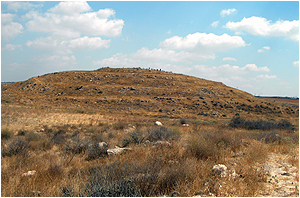
Fig. 1. Tel 'Eton (Tell 'Aitun) |
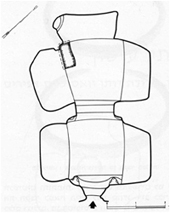
Fig. 2. Plan of Tomb 1 with carved animal heads |
 |
Four robbed rock-cut tombs dating to the 9th and 8th centuries BCE were investigated by Prof. David
Ussishkin. The tombs are characterized by their architecture (Fig. 2). A few steps lead from a small, square
entrance to the floor of the chamber. Two piers divide the chamber into two parts. The dead were placed
in arcosolia, that is, burial niches cut in the walls of the chamber. A repository for bones is usually located
at the back of the chamber. Small niches for placing lamps were cut in the walls of the chamber and the
arcosolia.
Unique animal carvings decorating shelves and niches for placing lamps were discovered in Tomb 1. Two
crude lions flank the entrance (Fig. 3), their flat tops apparently serving as shelves for lamps (Fig. 4a-b).
Animal heads were carved on the walls between the arcosolia. Two nicely carved animal heads topped by
emplacements for lamps were carved on the walls between the piers in the centre of the chamber (Fig. 5).
|
Soundings on the Site
A small-scale salvage excavation was undertaken in August 1976 on the summit of the site. The excavation
was carried out within the framework of the Lachish excavation project on behalf of the Institute of
Archaeology of Tel Aviv University and the Department of Antiquities and Museums. The excavation was
directed by Prof. David Ussishkin, and supervised by Eitan Ayalon. The excavated trench was made of a single
row of four 5 by 5 m squares, oriented across the summit.
Remains of two architectural strata were uncovered. The excavated area, however, was too small to establish
the plan or nature of the remains. In
|
 |

Fig. 3. Carved lions flanking the entrance of Tomb 1 |
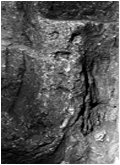  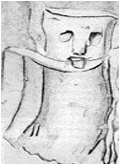
Fig. 4a-b. Tomb 1: Lion on left-hand side of entrance |
 |
general, it seems that the layout of Stratum II was continued in Stratum I, with certain modifications.
The pottery of the two strata shows much resemblance; it can be compared to the
pottery of Levels IV and III at Tel Lachish, and apparently dates to the 9th and 8th centuries BCE.
|
 |
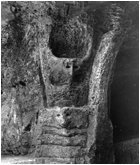
Fig. 5. Tomb 1: Pier with animal head |
Publications
D. Ussishkin, Tombs from the Israelite Period at Tel 'Eton, Tel Aviv 1, 1974, pp. 109-127.
G. Edelstein, D. Ussishkin, T. Dothan and V. Tzaferis, The Necropolis at Tell 'Aitun, Qadmoniot 4, no. 3 (15), pp. 86-90, (Hebrew).
E. Ayalon, Trial Excavation of Two Iron Age Strata at Tel 'Eton, Tel Aviv 12, 1985, pp. 54-62.
O. Zimhoni, The Iron Age Pottery of Tel 'Eton and Its Relation to the Lachish, Tell Beit Mirsim and Arad Assemblages, Tel Aviv 12, 1985, pp. 63-90.
|







